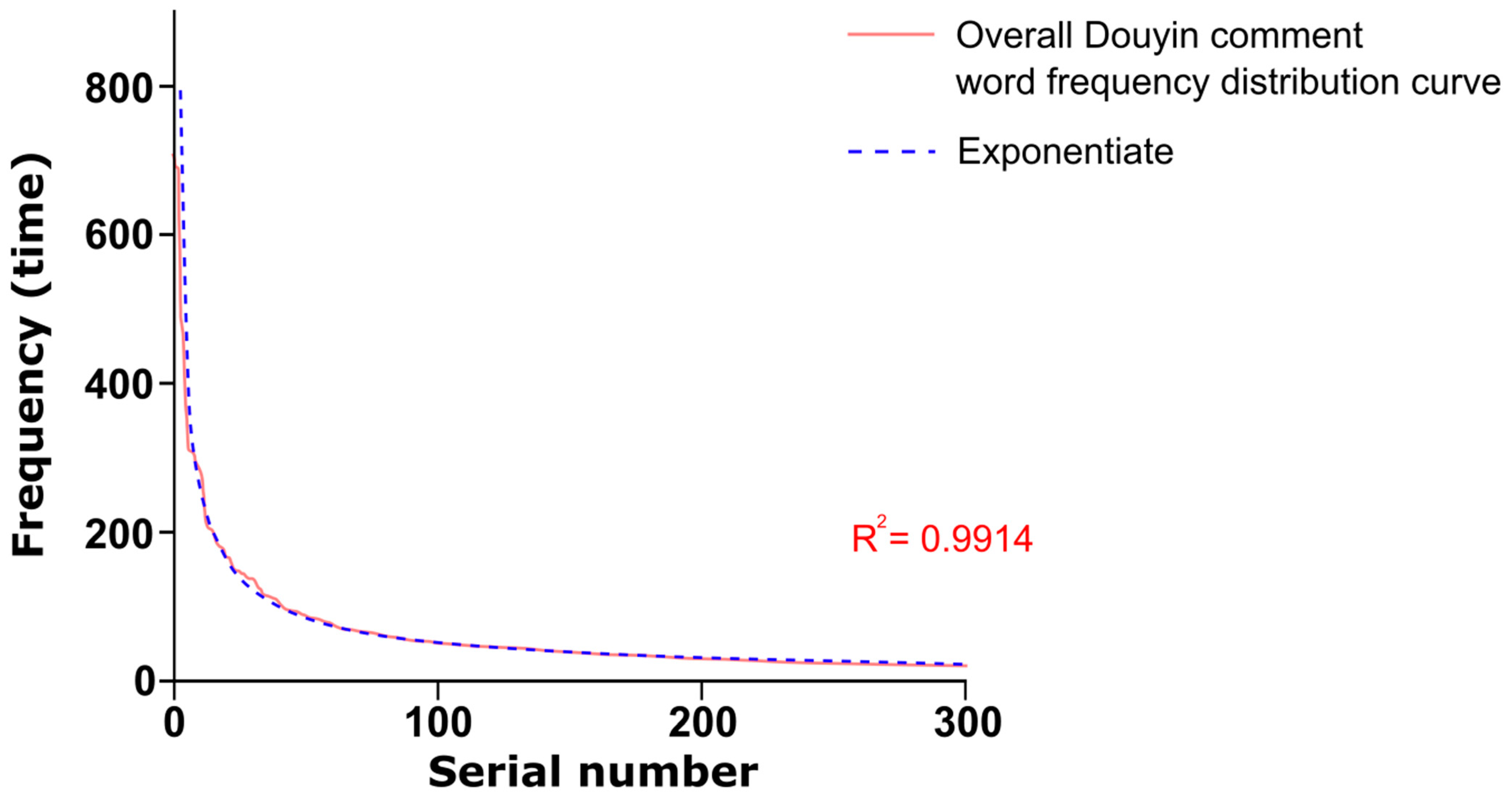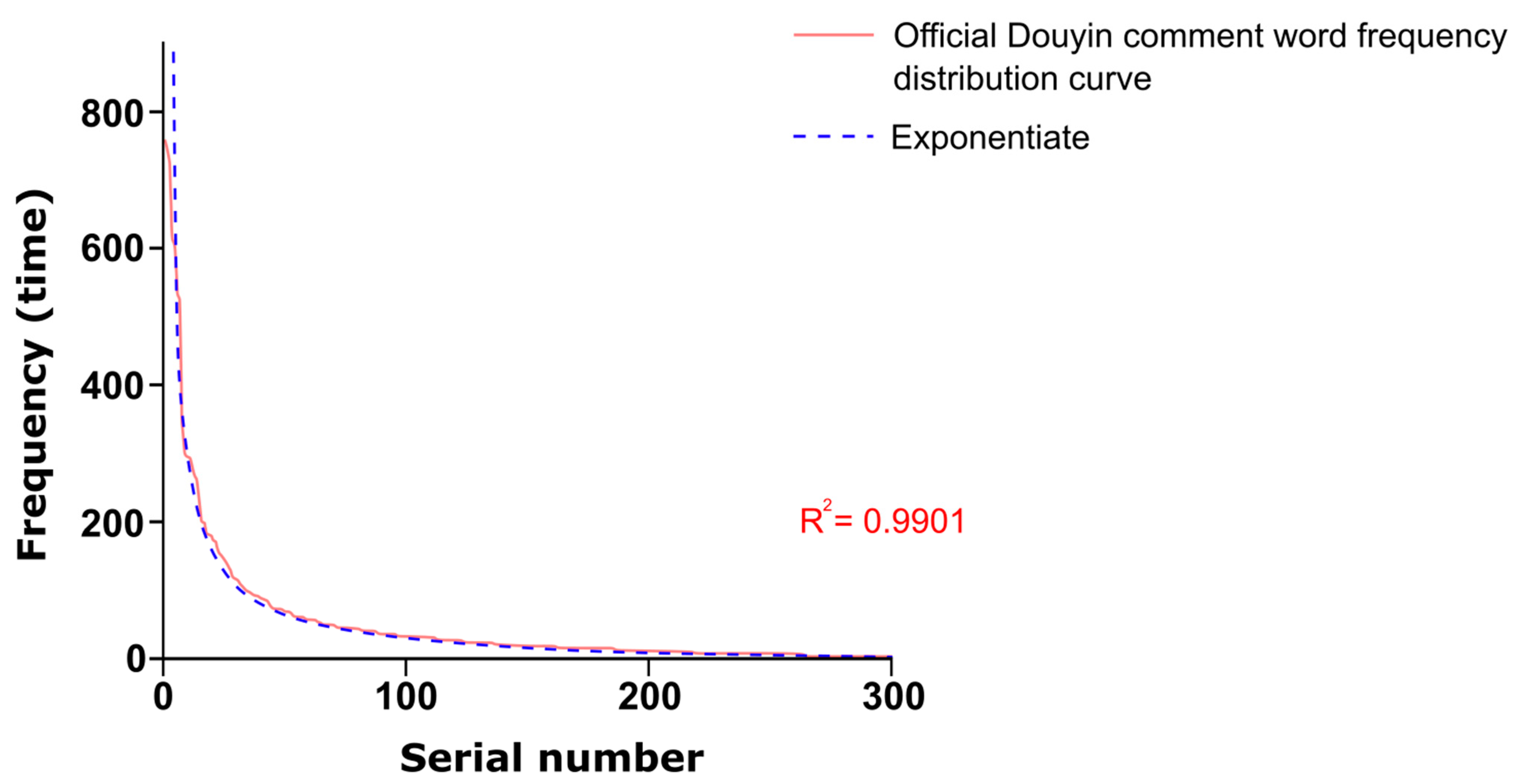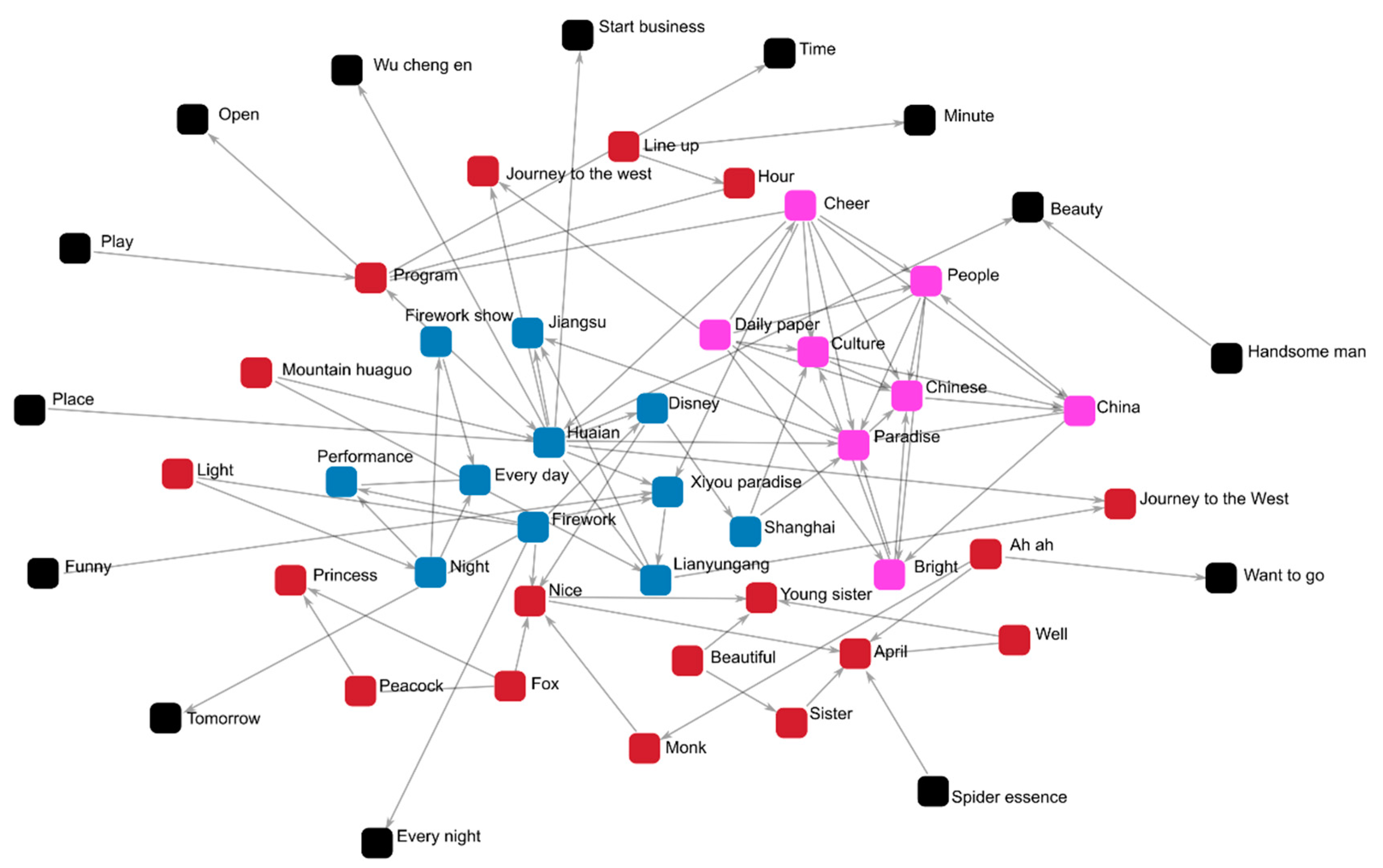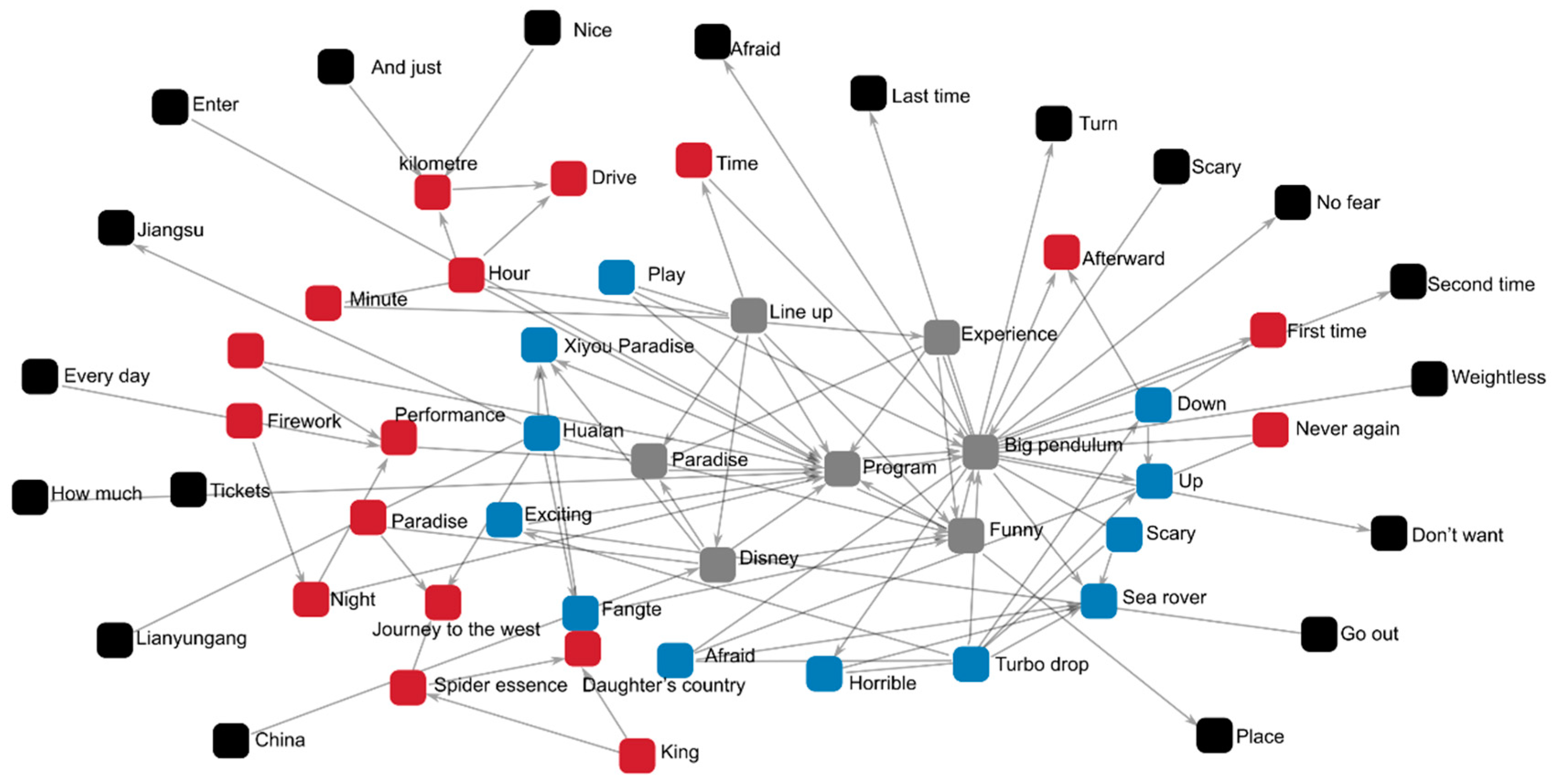Impact of Short Video Marketing on Tourist Destination Perception in the Post-pandemic Era
Abstract
:1. Introduction
2. Literature Review
2.1. Short Video Marketing
2.2. Research on Short Video Marketing
3. Research Methodology and Data Sources
3.1. Sample Selection
3.2. Research Methodology
3.2.1. Text Analysis
3.2.2. Word Frequency Analysis
3.2.3. Semantic Network Analysis
3.2.4. Emotional Analysis Method
- (1)
- High-frequency words related to amusement facilities: “big pendulum”, “jump plane”, “April”, “fireworks show”, and so on. Related comments, such as “the fireworks show and drones at night are really beautiful, and the guy working inside is very gentle. I will definitely go there again” reflected the satisfaction and attention of tourists to the amusement facilities in Xiyou Paradise.
- (2)
- High-frequency words related to tourist destinations: “Disney”, “fantasy”, etc. These words reflected that tourists compared Xiyou Paradise with Disney and other theme parks, which raised awareness of Xiyou Paradise but also puts pressure on Xiyou Paradise, which needed to highlight its own characteristics to win the top position among theme parks. The words “Huai’an” and “Lianyungang” related to the intellectual property (IP) of “Journey to the West”: Huai’an is the hometown of Wu Chengen, the author of Journey to the West, and Lianyungang is the location basis of the fictional Mountain Huaguo. The opening of Huai’an Xiyou Paradises stirred active discussion in the comments of the related videos Xiyou Paradise, reaching viral status.
- (3)
- High-frequency words related to tourists’ perception: “nice”, “beautiful”, “scary”, “horrible”, etc. Related comments included, “I like it better than Disney’s fireworks show”, “The costumes in Journey to the West are really beautiful”, “The big pendulum is really nice when you open your eyes and look outside at the highest point.” In addition, the words “scary” and “horror” were used to describe the thrill rides.
- (4)
- High-frequency words related to travel companions: “children”, “friends”, “students”, etc. Related comments were “Last week, I took the children to go. It was really nice”, and “I went with my boyfriend last time. He said it is not at all scary, but when I tried a few attractions, I was scared the whole time. After, I could only dare to try the carousel. I will never go again. I was especially scared in the three white bone spirit attraction”, “I was so scared, but I was embarrassed to call anyone”, and so on. The comments indicated that Xiyou Paradise was for all ages—children, young people, and older adults can find their own fun in Xiyou Paradise.
- (5)
- High-frequency words related to the theme: “monk”, “goblin”, “Journey to the West”, “woman country”, etc. Related comments included “the spider spirit plays a really similar role to the one in Journey to the West, and suddenly I feel older”, “I wanted to watch the monkeys when I was a child”, and “I want to go to see Journey to the West again”, reflecting Xiyou Paradise not only restored classic works but also aroused cultural sympathize in tourists. This had a positive effect on the satisfaction of tourists, revisit intention, and spread of word of mouth.
4. Analysis and Result
4.1. Word Frequency Analysis of the Perception of Xiyou Paradise under Different Routes
4.2. Semantic Network Analysis
4.3. Sentiment Analysis
4.4. Analysis Overview
5. Conclusions and Discussion
5.1. Conclusions
- (1)
- Regarding the marketing aspect, tourist destinations generally carry out short video marketing through two platforms, such as official Douyin accounts, and commissioned short Douyin videos made by influencers. Because of their higher fan base, exposure, interactivity, and professional short video production techniques, opinion leaders can obtain a large number of likes, comments, and retweets for the short videos they produce. When marketing tourism destinations, they may thus obtain satisfactory marketing effects. The short videos produced by administrators of tourism destinations are not worse than those produced by opinion leaders in terms of production technology but their exposure is rendered insufficient by the limited reach of official accounts. Moreover, the official social media accounts of tourist destinations have less interaction in their communities, which leads to fewer likes, comments, and retweets when marketing Douyin short videos. Ultimately, the final marketing effect is not good.
- (2)
- Regarding content, the short video marketing of tourism destinations focuses on the visual and audio aspects, such as excellent visual effects and strong infectious music to attract attention and achieve a better marketing effect. However, short video marketing should also pay attention to the deeper connotation of tourism destinations, such as the history and culture of tourism destinations, anecdotes, and spiritual content. In other words, we noted a lack of effective means to achieve better marketing effects. Marketing through audio-visual and other energy levels can achieve a strong marketing effect but only in the short term and in a superficial manner that encourages tourists to ignore the deep connotation of the tourist destination. To attract tourists, destination administrators should leave a deep and lasting impression. They can do so by ensuring that the connotation of tourist destinations is expressed in enjoyable short videos.
5.2. Discussion
- (1)
- Tourism destinations should use scenario experiences that trigger emotional sympathy to attract tourists. At present, the tourism industry has been transformed and upgraded, and tourism products have shifted from direct viewing to customized, quality, and participatory experiences. As the entrance to connect the audience and tourism enterprises, the direct experience of tourists is the most crucial factor in the short video scene. Under the “new 4C rule”, a scene is the sum of the marketing environment including time, place, people, and emotion, and is a specific, experienceable, and ultimately realizable content value scene created through five technical supports: big data, mobile devices, social media, sensors, and positioning system. Due to the limitation of presentation time, a short video can be regarded as a connection of fragmented real scenes, providing audiences with a virtual reality scene experience through the splicing of fragmented real scenes and audio-visual co-presentation, strengthening the audience’s sense of “physical” presence. By creating the IP of the West Tour, the West Tour Land has aroused the public’s sympathy. In the short video, more attention is paid to creating scenes that fit the emotional needs of the target audience, so that the audience can have a sympathetic emotional perception in line with the value of the attraction.
- (2)
- Tourism destination managers should build communities with a sense of belonging and activity. In his book Community and Society, German sociologist Ferdinand Tönnies divided “community” into three types: blood, geopolitical, and spiritual community. The meaning of online community is similar to the aforementioned “spiritual community”: a group formed by common interests without the constraints of blood and geography. Tourism short video communities are groups formed by viewers in the virtual space of short videos based on the same preferences or attitudes toward tourism products, brands, and services. Tourism destinations should create discourse with members through scenes based on emotional identity, and members may express their attitudes or generate sharing behaviors through feedback on the content or topics of the scenes to generate a strong sense of group value identification and identity. The continuous interaction among community members serves as the endogenous driving force for the sense of belonging. Therefore, stimulating participation and keeping the community active should be at the core of short video community marketing. In practical terms, tourism destination managers should always pay attention to the interactions in the comment section when using short videos for marketing. Such interactions increase the sense of belonging of fans while also enhancing community activity.
- (3)
- Tourism destination managers should focus on the continuous production of topical, high-quality content. According to the above elaboration on the concept of scene and community elements, the proliferation of marketing content is essentially one of the fundamental purposes of scene building and community construction. Advances in artificial intelligence, intelligent terminals, and mobile communication technology will usher in the era of the Internet of Everything when the diffusion of information and channels will not be limited by the network traffic and medium. In such a future, the role of marketing content will become even more prominent. The continuous dissemination of high-value, strong, creative content will help companies and communities maintain “stickiness” and achieve ultimate profitability. Short video marketing should seize the hot issue, around the hot issue production video.
- (4)
- In the 1940s, Lazarsfeld, an American communication scholar investigating the influence of mass communication on voters’ opinions, found that “the mass media do not act directly on the audience, but through the secondary communication of opinion leaders to the general audience”. In occupying the central node of a communication network, opinion leaders, who are in constant contact with the media, have a comprehensive knowledge of the corresponding field of information and unconsciously filter and process the media messages they pass along to the audience. The audience does not need to distinguish the value of information, but their opinions or attitudes will be inevitably influenced by the central node. In the mobile internet era, anyone can become the central node of communication in a network, and the diffusion path of information will become a kind of net-like communication structure that spreads from the central node to the general nodes. Therefore, tourist destinations like Xiyou Paradise can invite “net” celebrities and travel vloggers to promote their short videos. In addition, it is also necessary to pay attention to the cultivation of the development of local “net” celebrities.
Author Contributions
Funding
Institutional Review Board Statement
Informed Consent Statement
Data Availability Statement
Conflicts of Interest
References
- Gössling, S.; Scott, D.; Hall, C.M. Pandemics, tourism and global change: A rapid assessment of COVID-19. J. Sustain. Tour. 2021, 29, 1–20. [Google Scholar] [CrossRef]
- Hall, C.M.; Scott, D.; Gössling, S. Pandemics, transformations and tourism: Be careful what you wish for. Tour. Geogr. Int. J. Tour. Space Place Environ. 2020, 22, 577–598. [Google Scholar] [CrossRef]
- Hanafiah, M.H.; Zain, N.A.M.; Azinuddin, M.; Shariffuddin, N.S.M. I’m afraid to travel! Investigating the effect of perceived health risk on Malaysian travellers’ post-pandemic perception and future travel intention. J. Tour. Futures, 2021; ahead-of-print. [Google Scholar]
- Matiza, T.; Kruger, M. Ceding to their fears: A taxonomic analysis of the heterogeneity in COVID-19 associated perceived risk and intended travel behaviour. Tour. Recreat. Res. 2021, 46, 158–174. [Google Scholar] [CrossRef]
- Xiao, S. Analysis of marketing strategy of short video application. Mod. Mark. 2019, 1, 100–101. [Google Scholar]
- China Internet Network Information Center Releases the 50th Statistical Report on the Development of the Internet in China. Natl. Libr. J. 2022, 31, 12.
- Ma, H. Study on the audience psychology of short-form video App—A case study of Douyin. News Res. Guide 2018, 5, 1–6. [Google Scholar]
- Omar, B.; Wang, D. Watch, share or create: The influence of personality traits and user motivation on Douyin mobile video usage. Int. J. Interact. Mob. Technol. 2020, 14, 121–137. [Google Scholar] [CrossRef]
- Lu, X.; Lu, Z. Fifteen seconds of fame: A qualitative study of Douyin, a short video sharing mobile application in China. In International Conference on Human-Computer Interaction; Springer: Berlin/Heidelberg, Germany, 2019; pp. 233–244. [Google Scholar]
- Wang, Y. Humor and camera view on mobile short-form video apps influence user experience and technology adoption intent, an example of TikTok (DouYin). Comput. Hum. Behav. 2020, 110, 106373. [Google Scholar] [CrossRef]
- Villaespesa, E.; Wowkowych, S. Ephemeral storytelling with social media: Snapchat and Instagram stories at the Brooklyn museum. Soc. Media Soc. 2020, 6, 2056305119898776. [Google Scholar] [CrossRef]
- Zhang, J.; Wang, J.D. Marketing Communication of Short video in the New Media Age: A Case Study of Douyin. J. Hangzhou Norm. Univ. 2020, 42, 113–120. [Google Scholar]
- Li, J.Q. Analysis of marketing strategies of short video applications—Douyin APP as an example. TV Guide 2018, 11, 140+142. [Google Scholar]
- Xie, H. Discussion on the successful mode of self media video advertising marketing—Taking “a” video as an example. J. Mod. Mark. 2018, 1, 59. [Google Scholar]
- Wang, J.X. Research on the development and trend of online video marketing. J. Productivity Research. 2018, 8, 118–122. [Google Scholar]
- Liu, H.Y.; Yan, M.J. Research on the impact of mobile short video use on travelers’ behavioral intentions. J. Tour. 2021, 36, 62–73. [Google Scholar]
- Lu, F. Tourism destination promotion and marketing in the new media era. J. Tour. 2018, 33, 1–3. [Google Scholar]
- Li, F.P.; Tao, C.; Chen, Y.Y. The analysis of UGC short videos promoting the image communication of traditional villages: A case of Hemu Village image communication on Douyin. J. Huazhong Norm. Univ. 2022, 56, 903–912. [Google Scholar]
- Dong, S.S.; Ge, P.P.; Shang, P.F. Analysis of the problems and countermeasures of the marketing of short video APP of Racer. Hebei Enterp. 2019, 2, 116–117. [Google Scholar]
- Liu, L.J.; Wu, W.T. Strategic analysis of enterprises’ marketing by short video. Bus. Econ. 2019, 78–79+104. [Google Scholar]
- Tang, X.T. Ignite Community: New 4C Rules of Mobile Internet; Machine Press: Beijing, China, 2015. [Google Scholar]






| NO | Overall | Official | Unofficial | NO | Overall | Official | Unofficial |
|---|---|---|---|---|---|---|---|
| 1 | want to go | monk | want to go | 26 | go out | night performance | Xiyou Paradise |
| 2 | big pendulum | April | km | 27 | daughter’s country | place | paradise |
| 3 | km | Huai’an | big pendulum | 28 | next time | Journey to the West | place |
| 4 | funny | fireworks show | funny | 29 | want to play | sister | paradise |
| 5 | Huai’an | nice | Huai’an | 30 | tomorrow | time | scary |
| 6 | nice | want to go | program | 31 | Fangte | how much | want to play |
| 7 | program | beauty | nice | 32 | young sister | Mountain Huaguo | go out |
| 8 | Disney | Xiyou Paradise | turbo drop | 33 | queen | China | last time |
| 9 | spider woman | night | Disney | 34 | how much | woman country | afterwards |
| 10 | turbo drop | program | spider woman | 35 | don’t want | evil spirit | night performance |
| 11 | sea rover | beautiful | sea rover | 36 | minute | light | woman country |
| 12 | ticket | Disney | afraid | 37 | princess | Chinese | next time |
| 13 | hour | Lianyungang | ticket | 38 | past | peacock | Fangte |
| 14 | Journey to the West | young sister | thrill | 39 | go up | hour | Jiangsu |
| 15 | firework | paradise | play | 40 | take photo | paradise | night |
| 16 | line up | funny | hour | 41 | cute | spider woman | beauty |
| 17 | beautiful | ticket | line up | 42 | kid | next time | take photo |
| 18 | Xiyou Paradise | every day | come down | 43 | first time | performance | firework |
| 19 | play | line up | April | 44 | Journey to the West | Tang Monk | Lianyungang |
| 20 | monk | cheer | Journey to the West | 45 | family | fairy | kingdom |
| 21 | night | Journey to the West | evil | 46 | fit | fireworks show | don’t go |
| 22 | place | fireworks show | beautiful | 47 | joyful | float | Tang Monk |
| 23 | Lianyungang | tomorrow | horrible | 48 | culture | open | tomorrow |
| 24 | horrible | princess | afraid | 49 | super | site | Journey to the West |
| 25 | night performance | fox | experience | 50 | safe | culture | COVID-19 |
| Layer | Overall | Official | Unofficial |
|---|---|---|---|
| Core layer | Huai’an, Western Paradise, fireworks show, fantasy, experience, show, night, big swing, jumper, pirate ship, time, exciting, playful, dare, scary | Huai’an, Xiyou Paradise, fireworks show, Shanghai, Disney, Jiangsu, Lianyungang, fireworks show, daily, night, show | Huai’an, Xiyou Paradise, Fantasy, play, exciting, do not dare, horror, up, down, jumper, pirate ship, scary |
| ub-core layer | Disney, amusement park, fun, queue, project | Paradise, people, daily, cheer, culture, Chinese, China, bright | Disney, amusement park, fun, queue, project, pendulum, experience |
| Transition layer | Journey to the West, night, Lianyungang, every day, place, down, horror, paradise, culture, China, spider spirit, daughter’s land, king, April, good-looking, three-hit white bone spirit, kilometers, drive, hours, minutes | Journey to the West, queue, hours, west, wow, well, April, sister, pretty, miss, monk, fox, good-looking, peacock, princess, lights, Mountain Huaguo, project | Journey to the West, first, then, drive, kilometers, time, hours, never, minutes, night, fireworks show, show, paradise, night, spider spirit, daughter’s land, king |
| Edge layer | Jiangsu, weightless, tickets, how much, then, first, second, out, in, don’t want, spin, last | Wu Chengen, opening, time, minutes, beautiful, handsome, want to go, spider spirit, every night, tomorrow, fun, place, play, open | Tickets, how much, Lianyungang, China, every day, Jiangsu, go in, also, look good, scared, last, spin, scary, not afraid, second, weightless, do not want, go out, place |
| Analysis Results | Douyin Comments | |
|---|---|---|
| Number of Texts/Articles | Percent% | |
| positive emotions | 9728 | 36.17% |
| neutral emotions | 12,543 | 46.63% |
| negative emotions | 4626 | 17.20% |
| Analysis Results | Douyin Comments | |
|---|---|---|
| Number of Texts/Articles | Percent% | |
| positive emotions | 1862 | 37.10% |
| neutral emotions | 2531 | 50.43% |
| negative emotions | 626 | 12.47% |
| Analysis Results | Douyin Comments | |
|---|---|---|
| Number of Texts/Articles | Percent% | |
| positive emotions | 7945 | 35.89% |
| neutral emotions | 10,177 | 45.98% |
| negative emotions | 4017 | 18.14% |
Disclaimer/Publisher’s Note: The statements, opinions and data contained in all publications are solely those of the individual author(s) and contributor(s) and not of MDPI and/or the editor(s). MDPI and/or the editor(s) disclaim responsibility for any injury to people or property resulting from any ideas, methods, instructions or products referred to in the content. |
© 2023 by the authors. Licensee MDPI, Basel, Switzerland. This article is an open access article distributed under the terms and conditions of the Creative Commons Attribution (CC BY) license (https://creativecommons.org/licenses/by/4.0/).
Share and Cite
Chen, H.; Wu, X.; Zhang, Y. Impact of Short Video Marketing on Tourist Destination Perception in the Post-pandemic Era. Sustainability 2023, 15, 10220. https://doi.org/10.3390/su151310220
Chen H, Wu X, Zhang Y. Impact of Short Video Marketing on Tourist Destination Perception in the Post-pandemic Era. Sustainability. 2023; 15(13):10220. https://doi.org/10.3390/su151310220
Chicago/Turabian StyleChen, Han, Xiaowei Wu, and Yiyao Zhang. 2023. "Impact of Short Video Marketing on Tourist Destination Perception in the Post-pandemic Era" Sustainability 15, no. 13: 10220. https://doi.org/10.3390/su151310220
APA StyleChen, H., Wu, X., & Zhang, Y. (2023). Impact of Short Video Marketing on Tourist Destination Perception in the Post-pandemic Era. Sustainability, 15(13), 10220. https://doi.org/10.3390/su151310220






